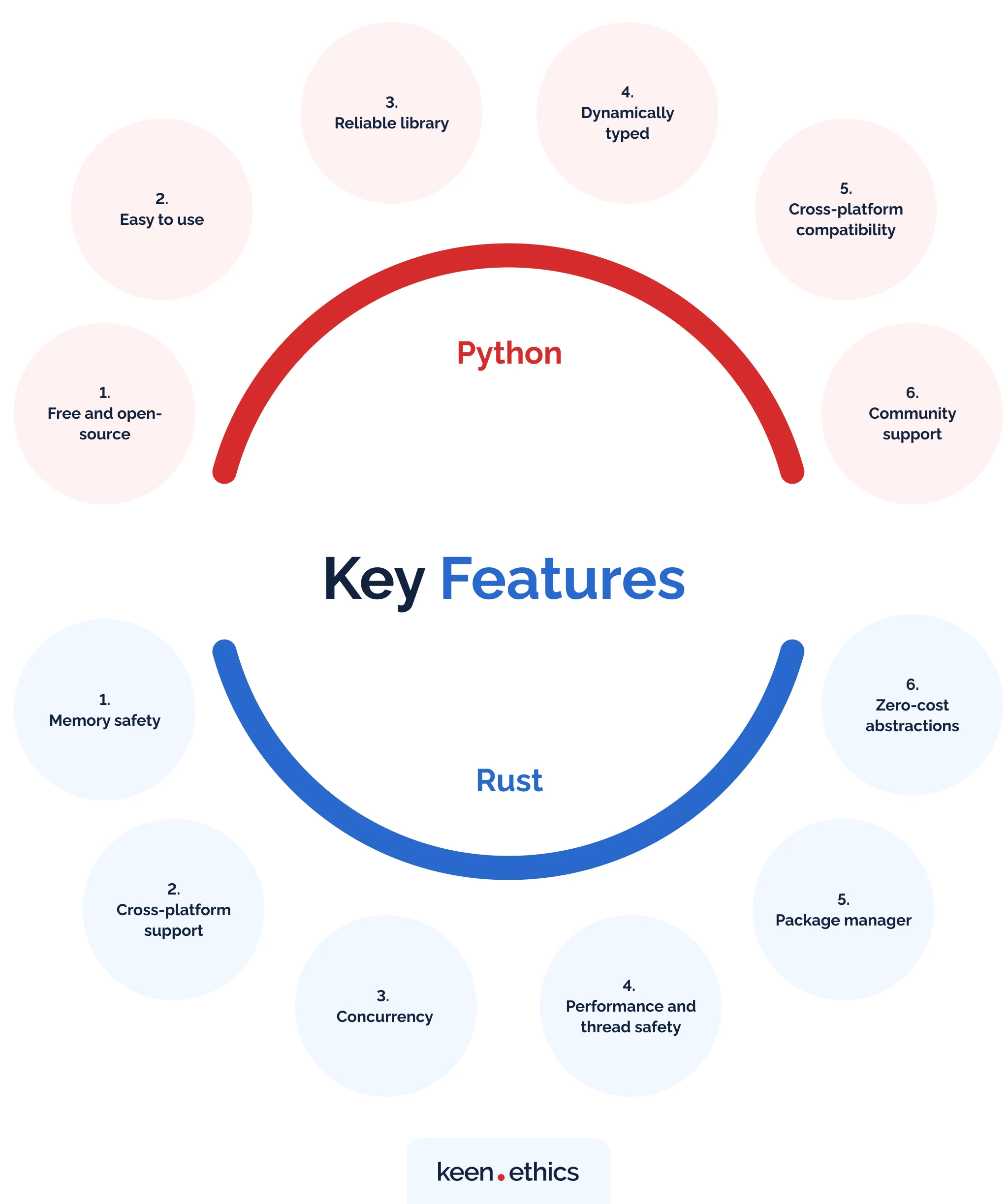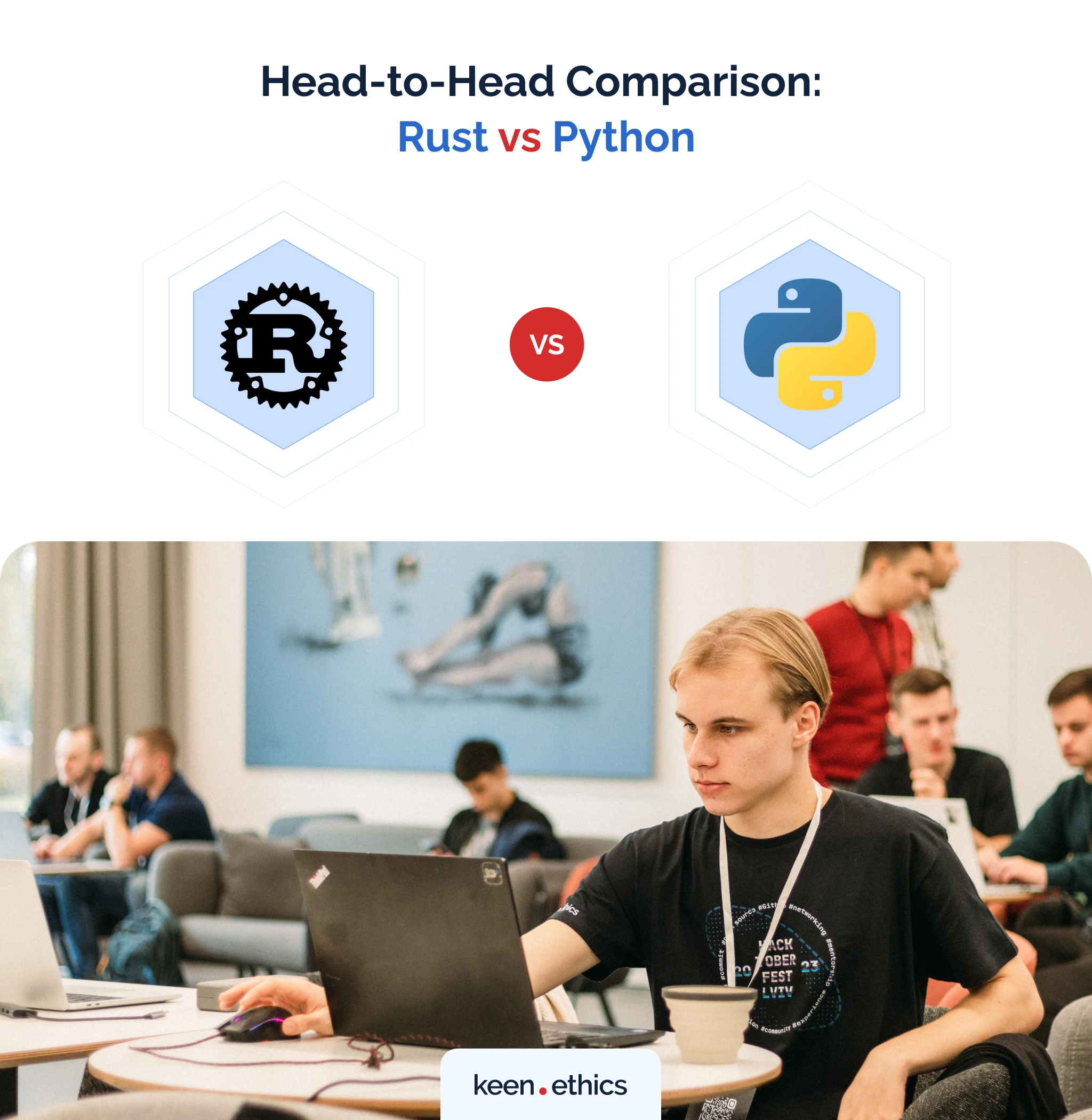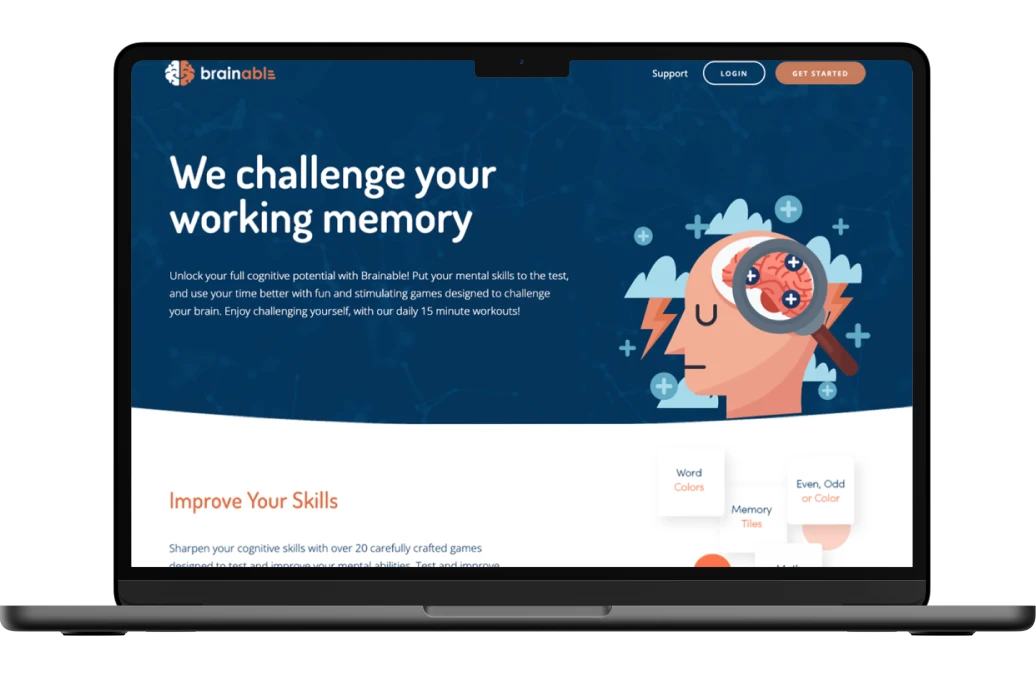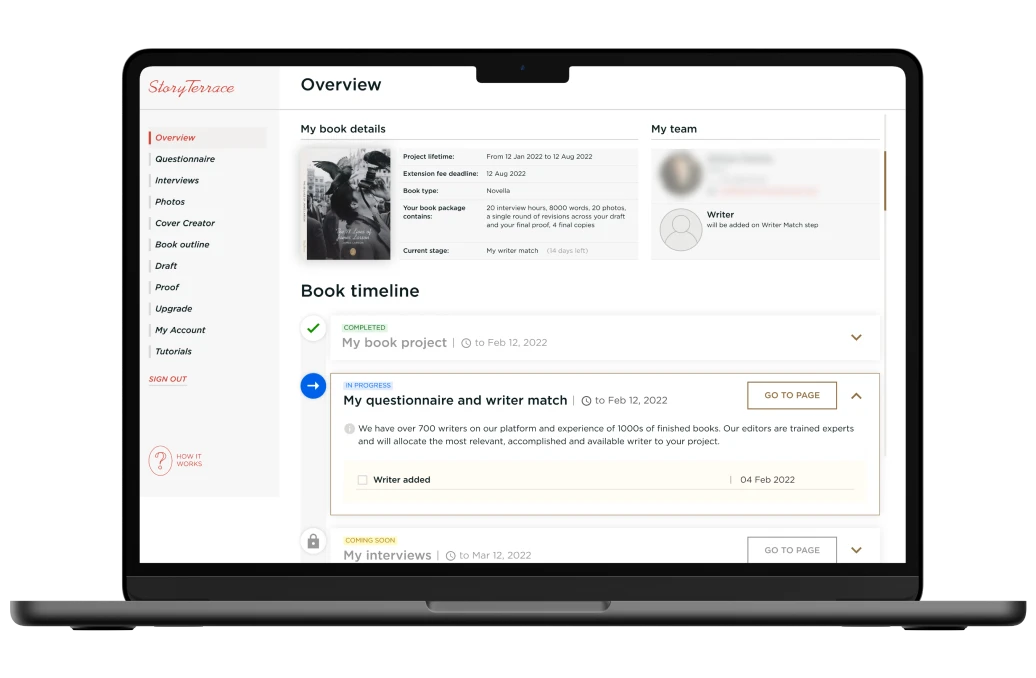Welcome to my complete guide to Rust vs Python, two reliable popular programming languages with their own strengths and use cases. In this article, we’ll define all the subtleties of both solutions, helping you navigate the decision-making process for your next project. Through this article, we focus on three audiences:
a newcomer interested in applying one of these languages and learning which is more versatile;
an experienced developer searching for a strong solution for advancing an existing project;
a client desiring to hire a web development team but to get a slight tech background to understand the basic concepts useful for your project.
Both languages have their pros, and in this article, we’ll discuss what they can offer you and how you can benefit from each of them when developing your digital solution. Let’s start with our full comparison of Rust vs Python.
What Is Rust?
Rust was first announced by Mozilla in 2010 and reached its 1.0 stable release in 2015. Rust as a programming language became popular thanks to its ability to create high-performance, safe, memory-efficient, and secure Rust apps. It’s an excellent choice for visualization, automation, testing, and more. Developers begin to use Rust often because it has its own unique set of features addressing common programming issues. It efficiently handles numerous concurrent events, which makes this language a functional tool for developing bug-free and robust software projects.
Who Uses Rust?
The Rust use cases can tell us much about the reliability and strengths of the language. For instance, Cloudflare used Rust to create an in-house HTTP proxy for serving over a trillion requests per day. Discord, a platform for messaging and voice communication, switched from Go to Rust to prevent delays with the Read States service. Amazon, a tech company selling all manner of goods for the home, uses Rust to maintain its speedy and secure software. The source control backend of Facebook was rewritten from Python in Rust, and considering the vast amount of sensitive data, Facebook had to choose a language with strong safety features. What’s more, Facebook refers to members of the Rust Foundation supporting growth and promoting the language. Dropbox, as a file hosting platform, uses Rust for the most critical elements their services depend on, including block storage and load balancing. Solana network used Rust for the blockchain network core, consensus algorithm, SDK, and Anchor framework building.
What Is Python?
Python is a general-purpose language that supports an object-oriented and functional programming paradigm with dynamic semantics. Created by Guido van Rossum and first released in 1991, this language became a great solution for rapid application development thanks to its dynamic typing and dynamic binding. It can be used for a range of use cases, including data analysis and machine learning, web development, automation, script testing, and prototyping. Its syntax is simple, allowing the developers to easily learn it, which, in turn, reduces the cost of program maintenance.
The language is easy to master for beginners and experienced developers. With its extensive library and third-party packages, developers can accomplish many tasks efficiently, from data analysis to developing virtual machine learning models. As with other programming languages, Python also boasts a vibrant community and support system, providing resources and excellent documentation for ongoing assistance.
Who Uses Python?
Python remains a popular choice among different institutions, such as financial companies, tech enterprises, government agencies, and those interested in web and software development. In general, Python is good for developing websites, apps, and software platforms. Also, data scientists use the language for computing vast amounts of data and accessing machine learning algorithms when working with AI.
In terms of use cases, Python is used by companies like Netflix, Uber, Google, Facebook, Pixar, and Spotify. By the way, YouTube, Pinterest, and Instagram are mostly written in Python. Google uses Python to build APIs and internal tools, for data analysis and AI research through libraries. Facebook uses the language for infrastructure automation, web development, and machine learning tasks within the platform.
Now, that we know the concepts of Rust vs Python, we can view the match between these two languages, find ways they differ, and see the benefits of making Python and Rust widely used.

Key Features of Rust
Now, it’s time to define the capabilities of Rust.
Memory safety
With Rust, developers don’t worry about software bugs or vulnerabilities. It ensures that memory is safe from memory-related bugs like buffer overflows and null pointer differences. Rust also allows you to write unsafe code if required. For instance, if you need functional compatibility with other languages, such as C++ or C, Rust provides a whole pool of tools.
Cross-platform support
Working with Rust, your product can run on different platforms, including Windows, Linux, and macOS.
Concurrency
Rust ensures the safe sharing of data between threads through its built-in support for ownership and borrowing system. Its concurrency model prevents the risk of bugs during mutable states and ensures thread safety during compilation.
Performance and thread safety
Rust’s zero-cost abstractions and focus on efficient memory management allow developers to write high-performance code without sacrificing safety. What’s more, Rust allows developers to write high-level, expressive code without incurring runtime overhead. Rust’s abstractions are optimized by the code compiler to generate efficient machine code, ensuring that there is no performance penalty for using high-level constructs.
Package manager
Rust provides developers with a Cargo package manager for simplifying dependency management, project prototyping, building, testing, and deploying products on Rust.
Zero-cost abstractions
Rust provides high-level abstractions that are free from runtime delays. When writing code, the developers shouldn’t worry about any performance penalties since the Rust compiler optimizes code by inclining, loop unrolling, and other optimizations to minimize runtime costs.
Key Features of Python
Free and open-source
By visiting the official website, you can install Python and use it without the need to purchase a license or pay any fees. The users don’t need to incur any costs related to licensing. Python’s source code is openly available to the public, allowing anyone to view, change, and share the code according to the license terms.
Easy to use
Python is easy to learn, and considering it’s a high-level programming language with straightforward syntax, it’s easy to code compared to other languages like C or JavaScript. Understanding the packages and modules also doesn’t take too much time. Well-known Python frameworks also make it easy to start developing and dive deep into them step by step.
Reliable library
The developers shouldn’t write the code for every single thing. Libraries of Python provide diverse functionalities like image manipulation, databases, and unit testing, along with thousands of needed components in the Python Package Index available for coding.
Dynamically typed
When writing programs in Python, we don’t need to remember the system architecture or manage memory. The benefit of Python is that variable types are determined and validated at runtime instead of compile time, which means that before using a variable, its type doesn’t need to be openly declared. The type can be dynamically changed when the program runs without any stops, allowing for flexible and dynamic programming. Being a dynamically typed language, Python offers benefits like flexibility, rapid prototyping and development, less code, readability, and expressiveness.
Cross-platform compatibility
Similarly to Rust, Python is compatible and can run smoothly on different operating systems, including Windows, macOS, and Linux. The developers save development time by writing the code once and deploying it on multiple platforms. For developers who want to create programs that run seamlessly on different platforms, Python is a versatile choice.
Community support
The Python community is large and supportive, offering its users support through a wide range of resources, including forums, online communities, and other open-source projects. While beginners can seek help and guidance, experienced developers can share their expertise and collaborate on projects.
Pros & Cons of Using Rust
Rust is a good pick, but it depends on what we compare it to. If defining the advantages of Rust, as a language for development in general, we’re going to provide the pros below. We’ll try not to double its pros with the features mentioned already since they also relate to the benefits of Rust.
Pros:
- Type inference enhances code readability and reduces verbosity by automatically determining the types of variables and expressions at compile time.
- Maintenance of Rust is high. Rust eliminates almost all critical issues, including invalid indexes, dangling pointers, memory corruption, and resource leaks.
- Its fast performance lies in Rust’s expressive syntax, powerful abstractions, and tooling ecosystem, which contribute to developer productivity and code maintainability.
- Improved memory model, which allows developers to prevent common problems related to data breaches. It allows you to properly manage memory, allocate values, and manage both control and security.
- Rust’s compiler offers detailed error messages so developers know how to handle them.
- Rust is a statically typed language, guaranteeing a low percent of type errors during runtime.
- Rust offers strong support for generics; its safety and code complexity are even more advantageous. Its syntax and patterns are diverse and rich, facilitating simple integration with C and several other languages, all while maintaining zero-cost abstractions.
Cons:
- The learning curve isn’t so complex, but it takes time to understand the concepts of language like ownership, borrowing, and lifetimes.
- Frequent updates. It’s released every six weeks and has new editions every three years. It’s not bad, but tracking all the updates and staying timely updated is difficult for developers.
- Rust has a smaller ecosystem than more established languages like Python.
- Rust is a bit of a complex language, requiring more time and effort to get coding knowledge to use the language to its fullest.
- Compilation time runs longer because of the strict type system and extensive compile-time checks, which can slow down the development iteration cycle.
- Since Rust remains a young language and its community continues to grow, in some cases, it’s necessary to implement custom libraries and modules.
Pros & Cons of Using Python
What are the benefits and drawbacks of using Python? And what are the features that make this language so popular? Let’s see.
Pros:
- Dynamic typing allows for checking of the runtime type during the execution of the program and generates a runtime error if the variable’s current type is incompatible.
- Thanks to its large active community, developers have plenty of resources, third-party libraries, tools, and built-in modules to employ for development.
- Writing code is simple thanks to its simple syntax. In addition, Python provides developers with proposal documents that can help them write efficient and readable code.
- Python is embeddable and can be efficiently integrated into other programming languages and apps. Its functionality can be linked to the functionality of existing software or used as a scripting language for off-the-shelf app development.
- Python processes and analyzes vast amounts of data and supports distributed computing.
- Since Python doesn’t require compilation, developers can develop the program in less time. The program can be run as soon as it’s written.
- Python allocates memory automatically, and developers don’t need to assign free space in memory. What’s more, its garbage collector recycles memory from discarded objects, allowing developers not to worry about memory leaks, invalid references or the size of the objects.
Cons:
- Python has a slow execution speed since it works with an interpreter instead of the compiler and executes code line by line.
- Python has limits on designs and requires more testing time. Therefore, the developers can see bugs only during the compilation of the program.
- The programming language has high memory consumption and isn’t the best fit for mobile and game development; however, it’s also used in these areas. This programming language consumes more memory than other popular languages like TypeScript, and when working with large datasets, developers can find it difficult to use memory efficiently.
- Python can have errors during runtime since its code isn’t compiled beforehand. As a result, it can lead to a higher debugging time eventually compared to other languages. What’s more, to minimize those errors timely, the app should be thoroughly tested by developers.
- Although programming with Python isn’t challenging, handling its database is complex. When working with it, developers note its primitiveness and underdeveloped layers. Therefore, Python is less used in development for larger businesses because larger projects require complex legacy data interactions.
- Python leads to longer testing times. Since all the errors are caught in the process, to successfully launch the output, the specialists should prevent or modify every error. The testing process is even more challenging. What’s more, if your program is integrated with other systems, testing may last longer.
- Python has some limitations due to things like GIL (Global Interpreter Locking), which were once necessary to build the language infrastructure at the interpreter level but have now become a limiting factor for limited multitasking, difficulties with data sharing, and unstable execution times.
Rust vs Python: Head-to-Head Comparison

Having listed all the features, pros, and cons of Rust and Python, you may be unsure which one is a more relevant fit for your project. Both are good, but what should you focus on when selecting one of them? Some of their features are similar, so to better come to this question, let’s opt for a single specific feature and define how each language behaves.
Learning curve
When it comes to ease of use and learning, Python wins. Rust has a more complex syntax structure and needs prior coding knowledge to develop. Since Python is easy to use, it’s used in a wider variety of fields compared to Rust. The benefit of Python is that developers can use fewer lines of code, so, in terms of use, Python is ahead.
Python is the winner
Performance
Although Python is strong for rapid development and prototyping, it’s not the best choice for complex apps. Due to its interpreted nature, dynamic typing, and runtime overhead costs during compilation, Python is slower vs Rust. Rust, in turn, shows high-performance and low-level control over system resources, and compiles to efficient native machine code, which means it suits most performance-complex programs.
Rust is the winner
Documentation
Both Python and Rust have documentation supported by the community. But while Rust is more oriented toward technical users, Python is easier to learn for beginners because of a lower layer of use and understanding of all the concepts.
Python is the winner
Memory safety
In terms of memory safety, Rust vs Python is stronger because of its ownership system, borrowing rules, and compile-time checks. On the one hand, Python ensures memory safety while reducing the risks of memory leaks and dangling pointers by relying on a garbage collector that manages safe memory allocation. On the other hand, since it has dynamic typing and lacks strict memory management rules, the language is less strong compared to Rust. Sometimes, Python can lead to memory-related runtime errors.
Rust is the winner
Security
Using Rust, you use “safe-by-default” mode, which means that most errors and security issues occur beforehand. Plus, the community of Rust contributes to the high security of the product and cares that no vulnerabilities occur. The language also provides the developers with Rust guidelines on how to create a secure and error-free app. But Rust vs Python is versatile and if you want to work with your code, have flexibility, and be responsible for your code security, you can also use unsafe Rust, another mode of the language. In turn, Python is also secure, but it lacks memory and thread safety. As a result, developers should configure memory management to secure their apps and prevent memory leaks.
Rust is the winner
Extensibility
On the one hand, Python is an old language; over the years, it has developed many libraries, and frameworks, and needed services to be able to support the language. On the other hand, in the last seven years in a row, Rust vs Python was the most loved programming language in the Stack Overflow developer survey. Although it has a longer learning curve and still needs popularity to develop its ecosystem, Python can provide more options for the extensibility of the product. But who knows? Maybe Rust will gain even more potential in the future.
Python is the winner
Features
It’s a critical factor to compare both, but the truth is that Python and Rust each offer distinct sets of features suited to different needs. Python boasts simplicity, versatility, and a vast ecosystem of libraries and frameworks, making it an ideal choice for rapid development, scripting, web development, data science, and machine learning. Rust prioritizes performance, memory safety, concurrency, static typing, and zero-cost abstractions, making it suitable for systems programming, embedded system development, and performance-critical apps. Rust’s ownership system and borrowing rules enforce memory safety at compile time, preventing common errors, while Python’s dynamic typing and interpreted nature allow for flexible and expressive code. The choice between Python and Rust depends on the specific project requirements, the desired performance level and safety, and the preferences of the developer or team.
Python vs Rust? Subjectively, the winner is under question
Community
The benefit of both is that both languages are open source. Accordingly, the developers can get all the needed resources, but for one thing. While Rust has fewer resources than Python, and they are harder to find, Python is more mature, with more resources and an easier way to find them. Python is popular and has a larger community than Rust, but then again, Rust’s community is small but highly active as well. Still, the winner is apparent.
Python is the winner
Conclusion: Which One is Better?
This comparison guide for Rust vs Python should have outlined the key differences to help you make an informed decision. In our article, we tried to shine a light on all the features, pros, and cons of both Python and Rust. And now, the question is: which language is the better choice for your project in the realm of Rust vs Python? Although the choice depends on your project needs and requirements, yet, you can analyze and compare their strengths and make your decision. While Python is a good fit for a wider range of apps, from web development, data science, machine learning, and scripting, Rust is good for performance-critical apps where safety is important. Both are good, and there is no definite answer to which tool is better. The question is more about selecting the right language for specific operations you plan to integrate. The philosophies of both languages differ. On the one hand, while Python is easy to learn, code, and maintain, Rust is a tool focusing on a bug-free and high-performance app, which makes it difficult to learn and employ. On the other hand, when perfecting a solution built on Rust, developers spend less time on its maintenance eventually. Also, Rust and Python have a strong connection, for building robust architectural solutions, where the advantages of both technologies can be used and not influenced by each other. If you have definite requirements and goals for your project, you can always hire a development team to help you define the strengths and weaknesses of the two languages. Keenethics, a software development company, can help you reach your goals by selecting the best languages and tools for your future project. If it’s Rust development services or Python development services, you can reach out to us to find the best solution together.
Share your vision and let us offer a solid architecture for your Rust or Python solution. Consult us to get all the benefits and a project estimate per your request.












